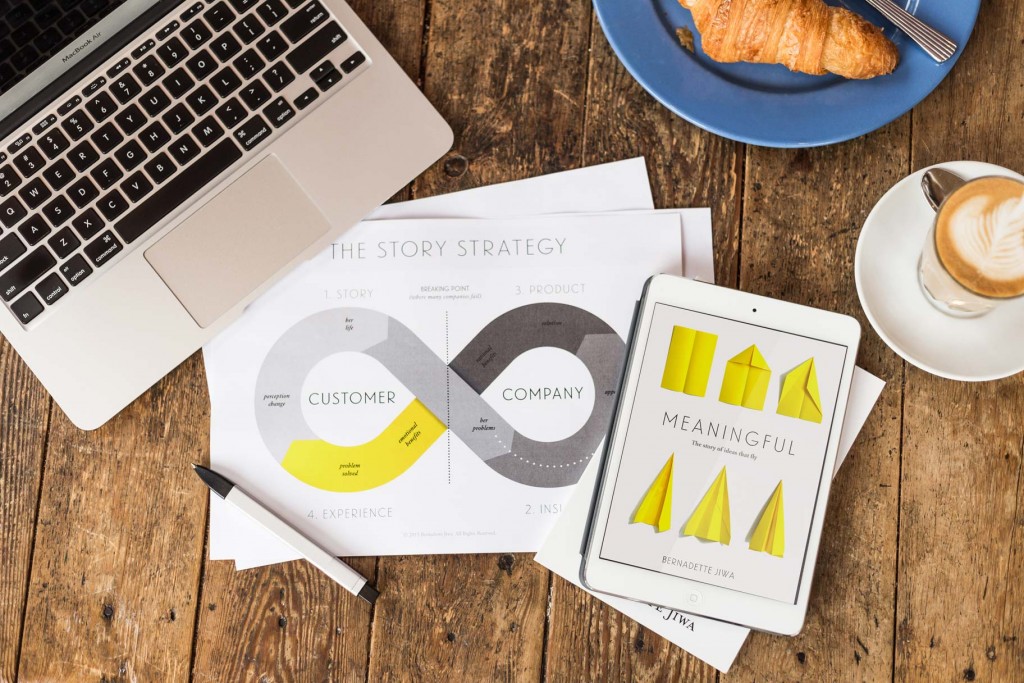Unlock the Magic in Your Story Now
Get the Free 20 questions to Ask Before Launching Your Idea workbook when you sign up for occasional updates.
Get the Free 20 questions to Ask Before Launching Your Idea workbook when you sign up for occasional updates.
Who Is This Not For?
filed in Marketing, Storytelling, Strategy
 When we spend time thinking about growing our businesses we tend to focus on our ideal customers—the people we know we want to matter to. A great way to get really specific about who you are creating your products and services for is to think about who they are not for.
When we spend time thinking about growing our businesses we tend to focus on our ideal customers—the people we know we want to matter to. A great way to get really specific about who you are creating your products and services for is to think about who they are not for.
The temptation in the short term is to be the brand that has the potential to serve everyone.
Giving in to that temptation is the road to a diluted, commoditised, interchangeable brand that doesn’t stand for much—one that gets used to making compromises to please everyone and anyone.
Do you want to attract the casual passerby who could just have easily walked into your competitor’s store today and will probably do that tomorrow?
Are you building your business to serve someone who responds to clickbait and lowest price offers?
Does it matter that the pay per click ads you buy deliver people who don’t truly value what you do?
Rock star brands that endure are never built by pleasing the masses.
You don’t have to fill every single seat in the auditorium.
Who would you rather not matter to?
Knowing the answer to that question and then living it is the foundation of a magnetic brand story.
Share this article
A New Book To Help You Create Ideas That Fly
filed in Marketing, Storytelling, Strategy
 I’ve spent the last two years writing, speaking and consulting about how to succeed by making your ideas resonate with the people you want to serve.
I’ve spent the last two years writing, speaking and consulting about how to succeed by making your ideas resonate with the people you want to serve.
My new book Meaningful: The Story Of Ideas That Fly is the culmination of that work.
Our new digital landscape has spawned an entrepreneurial culture and the belief that anyone with a laptop and an Internet connection has the power to change the world—to create an idea that flies. But for every groundbreaking business that started this way, a thousand others have stalled or failed. Why? What’s the secret to success? What do Khan Academy and the GoPro camera have in common?
After years of consulting with hundreds of innovators, creatives, entrepreneurs and business leaders to help them tell the stories of their ideas, I have discovered something: every business that flies starts not with the best idea, the biggest budget or better marketing, but with the story of someone who wants to do something—and can’t.
We don’t change the world by starting with our brilliant ideas, our dreams; we change the world by helping others to live their dreams. The story of ideas that fly is the story of the people who embrace them, love them, adopt them, care about them and share them. Successful ideas are the ones that become meaningful to others—helping them to see what’s possible for them.
Our ideas fly when we show others their wings.
This new book includes the stories and case studies of businesses that have become beloved brands by beginning their innovation and marketing journey with the customer’s story. It also introduces a new tool—the Story Strategy Blueprint to help you to do that too.
I hope this book enables you to get clear about the impact you are creating, for whom and that it empowers you to build the business you always wanted. Thanks for giving me a reason to write it.
Image by Karishma Kasabia. Book cover design by Reese Spykerman. Book layout by Kelly Exeter. It takes a village!
Share this article
Before You Pitch
filed in Marketing, Storytelling, Strategy
 At the end of the event a small group gathered around the presenter. He had flown in from Europe the day before and was bound to be jet lagged. Despite that he had delivered an informative and inspiring keynote about how his company—one of the most powerful brands in the world, used customer insights to innovate.
At the end of the event a small group gathered around the presenter. He had flown in from Europe the day before and was bound to be jet lagged. Despite that he had delivered an informative and inspiring keynote about how his company—one of the most powerful brands in the world, used customer insights to innovate.
A couple of people shook his hand and thanked him. The third guy to reach the top of the line began by explaining what his company did, mentioning that they were hoping to partner with the speaker’s brand. Next he pulled out his smartphone and started scrolling through screenshots of their product. The speaker glanced over his shoulder at the next person in the line apologetically.
Pitch guy was on a roll. He was face to face with a representative from one of the world’s leading brands and he didn’t want to waste the opportunity. He pressed on, making sure to communicate every last detail, without pausing for breath or to read the body language of the person he was pitching to. After five minutes he walked away with the speaker’s business card (clearly the goal he had set himself), which of course must have felt like a win. In the process of scoring that quick victory he forgot the first rule of pitching.
Before you try to make yourself understood, you need to work out why the person you are pitching to will care about what you have to say. We have all been pitch guy at one time or another. Typically when we pitch or sell we are primarily concerned about what we want the person on the receiving end to do next—give us his card, invest, make an introduction and on and on. What we really should be asking ourselves first is;
“Why exactly will what I am about to say next matter to this particular person?”
Just because someone heard what you had to say doesn’t mean it made an impression.
Image by Heinrich-Böll-Stiftung.
Share this article
The Ideal Business
 Something unexpected happened while I was on the phone to my health insurer making a quick change to personal details. The operator threw me by asking if I wanted to reduce my cover (and thus, the annual premium).
Something unexpected happened while I was on the phone to my health insurer making a quick change to personal details. The operator threw me by asking if I wanted to reduce my cover (and thus, the annual premium).
“No sense paying a fortune for something you don’t need.” she said.
True—but when I began to dig deeper I found that the higher tier of cover bundles claims for IVF and pregnancy, with mental health, hip and knee replacements and cataract operations together. If you opt out of one, you opt out of all. I was being down-sold to a policy that would not entitle my family to claim in any of these categories, because of course they are the most expensive claims for the insurer to fund.
After her third attempt to get me to switch, I began to wonder if there was some kind of reverse bonus in place at this company. Did the operator get a bonus for persuading people to downgrade their cover, potentially saving the insurer a small fortune?
If we reduced our cover it was a win for their business, but was definitely not the right thing for our family (even if I won’t be needing IVF or pregnancy cover any time soon).
The ideal business is one where the right thing for the business, is the right thing for the customer.
Those businesses are few and far between.
That’s why we seek them out and when we find them, we stick with them.
Image by Garry Knight.
Share this article
Most Marketing
filed in Marketing, Storytelling, Strategy
 Most marketing is designed to….
Most marketing is designed to….
Get attention in the moment.
Make people choose.
Create awareness among many.
Persuade people to decide.
Most marketing is not designed to….
Build loyalty over time.
Make people care.
Create affinity with a few.
Help people to feel good about their decisions.
What makes your marketing unlike most marketing?
Image by Onny Carr.
Share this article
The Most Powerful Thing You Didn’t Do Today
filed in Storytelling, Strategy
 Have you ever been footsteps away from a window and yet found yourself opening an app or doing a Google search to check the weather, instead of simply going over to the window and opening the curtains? Me too! Why is that?
Have you ever been footsteps away from a window and yet found yourself opening an app or doing a Google search to check the weather, instead of simply going over to the window and opening the curtains? Me too! Why is that?
We are now in the habit of outsourcing our thinking and second guessing our judgement because the right answer is always just a Google search away.
There are so many more demands on our time, we prioritise responding and reacting to other people’s questions and have left very little time to think about what’s important to ask ourselves.
We allow ourselves to be consumed by other people’s lives, thoughts and content to the detriment of living, prioritising and creating our own.
What are your important questions and what could you achieve, in both work and life by choosing to give yourself the space to answer them?
Image by Rennet Stowe.
Share this article
The 5 Building Blocks Of A Brand
filed in Marketing, Storytelling, Strategy
 A brand used to be an identifier, over the past seventy years it’s become so much more.
A brand used to be an identifier, over the past seventy years it’s become so much more.
Seth’s 2009 definition says it best.
“A brand is the set of expectations, memories, stories and relationships that, taken together, account for a consumer’s decision to choose one product or service over another.”
We can agree then that a brand is the meaning the customer attaches to a product or service from what she perceives. If PRODUCT + MEANING = BRAND, what creates the meaning?
5 Building blocks of a brand
1. What you (the founders and business owners) believe.
Your values, mission and vision.
2. Your voice—what you say and how you say it.
The words and tone you use to communicate your message.
3. What you do.
How you act.
4. How you make people feel.
Sometimes called user experience.
5. What you look like.
Logo, design choices, colours, seating, paper stock and on and on.
Branding is about how you facilitate the creation of meaning for your customers. The people you want to matter to need to be able to do more than recognise your brand, they need to know what it feels like to belong to it.
Image by Nina Jean.
Share this article
The New Rules Of Winning
filed in Marketing, Storytelling, Strategy
 Just three months ago Volkswagen surpassed Toyota to become the world’s largest automaker.
Just three months ago Volkswagen surpassed Toyota to become the world’s largest automaker.
It’s clear that selling more cars in order to beat that competition had been the company’s goal for some time. As we’ve seen in the past week biggest doesn’t necessarily mean best.
When we use shallow metrics to judge our performance we often fail to take account of things that are harder to measure, and yet are equally (if not more) important to building a sustainable business. When we get stuck in comparison we think about making incremental improvements, tweaking what’s been done before, instead of reimagining what’s possible.
Time and again in business we’ve seen that winners don’t compete—they reframe the problem, reinvent, create and conquer new challenges and run their own purposeful race.
Winning isn’t about being the biggest or beating the competition at all costs—it’s about intentionally changing tiny edges of the world for the better.
Image by Dark Dwarf.
Share this article
How To Make People Care About Your Product
filed in Marketing, Storytelling, Strategy
 The maître d’ had worked at the same restaurant for thirteen years and was ready for a change.
The maître d’ had worked at the same restaurant for thirteen years and was ready for a change.
He wanted to do work he was passionate about and decided to start a dog walking business—knowing that in order to succeed he needed to send a signal to prospective customers about how much their pets mattered.
His goal was to make people believe: ‘If this man is walking our dog, and there’s some sort of major disaster, he’s going to survive. He’s going to fish for those dogs. He’s going to build a bunker and shelter those dogs until it’s safe to bring them home.’
The marketing didn’t start with his story. It started with theirs.
The way to make people care is by first understanding what they care about.
Then you can tell the story you know they want to hear.
Image by Franklin Heijnen
 No self-respecting (or smart) cafe owner would describe his drip-filter coffee as 85% boiling water. Instead he tells the origin story of the coffee beans and the slow pour-over brewing process that augments the flavour. The barista creates retail theatre while you wait in line.
No self-respecting (or smart) cafe owner would describe his drip-filter coffee as 85% boiling water. Instead he tells the origin story of the coffee beans and the slow pour-over brewing process that augments the flavour. The barista creates retail theatre while you wait in line.